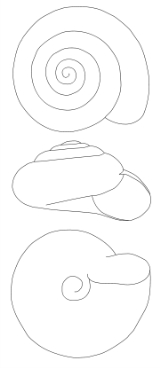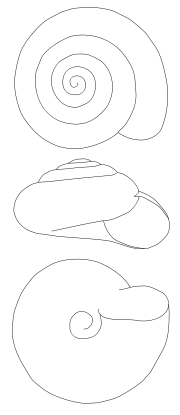
Zonitoides nitidus
Encyclopedia
Zonitoides nitidus is a species
of small, air-breathing land snail
, a terrestrial
pulmonate gastropod mollusk in the family Gastrodontidae
.
Zonitoides nitidus is the type species
of the genus Zonitoides
.
zone. It is found almost all over Europe except the southernmost regions:
The non-indigenous distribution of this species includes:
is reddish brown. The umbilicus is large (almost 25 % of shell diameter). The shell is with radial growth lines. The width of the shell is 6-7 mm. The height of the shell is 3.5-4.0 mm.
The animal is black with a characteristic orange dash: the (mantle
gland is visible under the shell's aperture
).
Juveniles are whitish grey with light brown translucent shells.
Zonitoides nitidus is herbivorous. These snails feed on disintegrating leaves, mushrooms, roots and fruit. They do not eat dry leaves. Humid leaves are preferred. When consuming soft food such as mushrooms or soft fruits, Zonitoides nitidus penetrates perpendicularly inside, producing characteristic holes; the entire animal including its shell can penetrate inside the fruit.
In Germany up to three clutches of 2-9 eggs per individual are laid in all seasons, with some days or weeks spacing between egg-laying. Egg diameter is 1.0-1.6 mm. Eggs are laid loose into the soil. Juveniles have 1.5 whorls
(diameter 1-1.2 mm) after hatching. They start feeding on disintegrating plant remains in the soil. After 3 months the shell diameter reaches up to 3 mm under favourable conditions, after 10 months 6 mm, and full size after slightly more than one year. Maximum age is 18 months under laboratory conditions.
Parasites of Zonitoides nitidus include:
Species
In biology, a species is one of the basic units of biological classification and a taxonomic rank. A species is often defined as a group of organisms capable of interbreeding and producing fertile offspring. While in many cases this definition is adequate, more precise or differing measures are...
of small, air-breathing land snail
Land snail
A land snail is any of the many species of snail that live on land, as opposed to those that live in salt water and fresh water. Land snails are terrestrial gastropod mollusks that have shells, It is not always an easy matter to say which species are terrestrial, because some are more or less...
, a terrestrial
Terrestrial animal
Terrestrial animals are animals that live predominantly or entirely on land , as compared with aquatic animals, which live predominantly or entirely in the water , or amphibians, which rely on a combination of aquatic and terrestrial habitats...
pulmonate gastropod mollusk in the family Gastrodontidae
Gastrodontidae
Gastrodontidae is a family of air-breathing land snails, terrestrial pulmonate gastropod mollusks in the clade Eupulmonata ....
.
Zonitoides nitidus is the type species
Type species
In biological nomenclature, a type species is both a concept and a practical system which is used in the classification and nomenclature of animals and plants. The value of a "type species" lies in the fact that it makes clear what is meant by a particular genus name. A type species is the species...
of the genus Zonitoides
Zonitoides
Zonitoides is a genus of air-breathing land snails, terrestrial gastropod mollusks in the family Gastrodontidae.- Distribution :The distribution of Zonitoides includes: North America, eastern and northern Asia, and Europe.-Species:...
.
Distribution
The distribution of Zonitoides nitidus includes the HolarcticHolarctic
The Holarctic ecozone refers to the habitats found throughout the northern continents of the world as a whole. This region is divided into the Palearctic, consisting of Northern Africa and all of Eurasia, with the exception of Southeast Asia and the Indian subcontinent, and the Nearctic,...
zone. It is found almost all over Europe except the southernmost regions:
- Czech Republic - least concern (LC)
- Netherlands
- Russia - Sverdlovsk oblastSverdlovsk OblastSverdlovsk Oblast is a federal subject of Russia located in the Urals Federal District. Its administrative center is the city of Yekaterinburg formerly known as Sverdlovsk. Population: -Geography:...
- Slovakia
- Great Britain - north British highland zones and not in north Scotland. In some regions in Britain the species has declined due to drainageDrainageDrainage is the natural or artificial removal of surface and sub-surface water from an area. Many agricultural soils need drainage to improve production or to manage water supplies.-Early history:...
. - Ireland
- Hebrides
- Orkney
- Shetland
- rare in northern Greece
The non-indigenous distribution of this species includes:
- introduced to Menorca
Description
The shellGastropod shell
The gastropod shell is a shell which is part of the body of a gastropod or snail, one kind of mollusc. The gastropod shell is an external skeleton or exoskeleton, which serves not only for muscle attachment, but also for protection from predators and from mechanical damage...
is reddish brown. The umbilicus is large (almost 25 % of shell diameter). The shell is with radial growth lines. The width of the shell is 6-7 mm. The height of the shell is 3.5-4.0 mm.
The animal is black with a characteristic orange dash: the (mantle
Mantle (mollusc)
The mantle is a significant part of the anatomy of molluscs: it is the dorsal body wall which covers the visceral mass and usually protrudes in the form of flaps well beyond the visceral mass itself.In many, but by no means all, species of molluscs, the epidermis of the mantle secretes...
gland is visible under the shell's aperture
Aperture (mollusc)
The aperture is an opening in certain kinds of mollusc shells: it is the main opening of the shell, where part of the body of the animal emerges for locomotion, feeding, etc....
).
Juveniles are whitish grey with light brown translucent shells.
 |
 |
Ecology
Zonitoides nitidus occurs in wet meadows and river woods, usually near water bodies, swamps and swampy forests, in the zone of emergent vegetation. Man-made habitats such as pools in old quarries are sometimes colonized after a few years. In Switzerland it is found up to 2100m of altitude.Zonitoides nitidus is herbivorous. These snails feed on disintegrating leaves, mushrooms, roots and fruit. They do not eat dry leaves. Humid leaves are preferred. When consuming soft food such as mushrooms or soft fruits, Zonitoides nitidus penetrates perpendicularly inside, producing characteristic holes; the entire animal including its shell can penetrate inside the fruit.
In Germany up to three clutches of 2-9 eggs per individual are laid in all seasons, with some days or weeks spacing between egg-laying. Egg diameter is 1.0-1.6 mm. Eggs are laid loose into the soil. Juveniles have 1.5 whorls
Whorl (mollusc)
A whorl is a single, complete 360° revolution or turn in the spiral growth of a mollusc shell. A spiral configuration of the shell is found in of numerous gastropods, but it is also found in shelled cephalopods including Nautilus, Spirula and the large extinct subclass of cephalopods known as the...
(diameter 1-1.2 mm) after hatching. They start feeding on disintegrating plant remains in the soil. After 3 months the shell diameter reaches up to 3 mm under favourable conditions, after 10 months 6 mm, and full size after slightly more than one year. Maximum age is 18 months under laboratory conditions.
Parasites of Zonitoides nitidus include:
- ElaphostrongylusElaphostrongylusElaphostrongylus is a genus of parasitic nematodes in the family Protostrongylidae.- Species :* Elaphostrongylus cervi Cameron, 1931* Elaphostrongylus panticola Lubinov, 1945* Elaphostrongylus rangiferi Mitskevich, 1958- Life cycle :...
spp. - Parelaphostrongylus tenuisParelaphostrongylus tenuisParelaphostrongylus tenuis is a small parasitic nematode that infects the brain of many ungulates. Its natural host, the white-tailed deer, is unaffected by its presence; other species, however, suffer severe neurologic damage that eventually leads to death...

